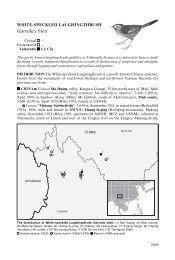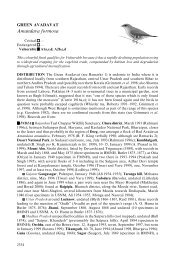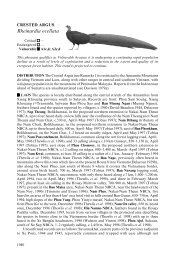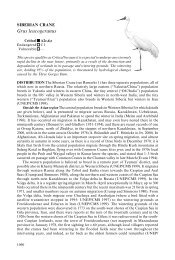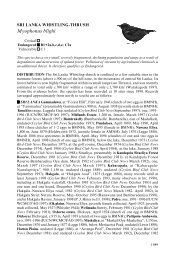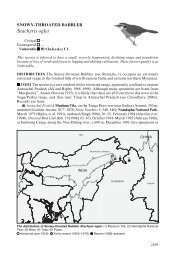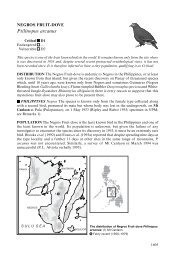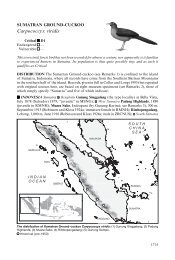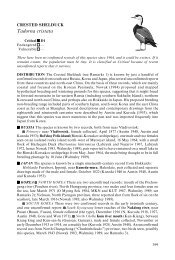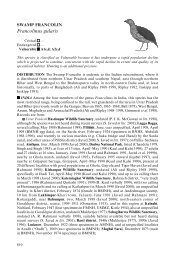Coturnicops exquisitus - BirdBase
Coturnicops exquisitus - BirdBase
Coturnicops exquisitus - BirdBase
You also want an ePaper? Increase the reach of your titles
YUMPU automatically turns print PDFs into web optimized ePapers that Google loves.
Threatened birds of Asia<br />
SWINHOE’S RAIL<br />
<strong>Coturnicops</strong> <strong>exquisitus</strong><br />
Critical —<br />
Endangered —<br />
Vulnerable C1<br />
This poorly known rail is inferred to have a small, declining population as a result of loss and<br />
fragmentation of wetlands in its breeding and wintering ranges. It therefore qualifies as Vulnerable.<br />
DISTRIBUTION Swinhoe’s Rail is known to breed at just a handful of wetlands in southeast<br />
Russia and in north-east China, and it has occurred on passage and in winter in Mongolia,<br />
Japan (including the Nansei Shoto islands), North Korea, South Korea and southern and<br />
eastern China.<br />
■ RUSSIA In Russia, it is known only from a few scattered localities in Transbaykalia<br />
(Chita), Amur and Primorye, with records (by province) as follows:<br />
■ Chita middle reaches of the Karenga river, left-bank tributary of the Vitim river, near<br />
to Tungokochen village, immature female collected and several other birds seen, October<br />
1962 (Gagina 1965a,b); lower Onon river, female collected and nest with three eggs found,<br />
1867 (Taczanowski 1873, Swinhoe 1876, Meise 1934, Dement’ev and Gladkov 1951–1954);<br />
■ Amur Albazin (Albacun), July 1906 (clutch of three eggs in BMNH, also Taylor 1998);<br />
Borzya river, Khinganskiy Nature Reserve, Amur valley, 20 km downstream from the mouth<br />
of the Bureya river, one flushed from a grassy swamp, May 1995 (Ryabtsev 1997, V. V.<br />
Ryabtsev in litt. 1997);<br />
■ Primorye wetlands between the Alchan river and the Bikin river, flushed from a grassy<br />
swamp, May 1997 (Mikhailov 1997); Sungacha river source, east shore of Khanka lake (see<br />
Remarks 1), in Khanakiski (Khanka) Nature Reserve, male collected, April 1868, clutch of<br />
four eggs collected in the Khanka lake lowlands, 1868 or 1869, the eggs being “originally<br />
incorrectly identified, but proved to belong to this species” (Neufeldt 1967), breeding at<br />
Khanka lake, undated (Knystautas 1993); Erdmana peninsula (De Friz peninsula), Peter the<br />
Great bay, April 1961, on a wet grassy islet (Labzyuk and Nazarov 1967); lower reaches of<br />
the Mongugay river (Barabashevka river), Peter the Great bay, collected, September 1976<br />
(Glushchenko and Shibnev 1977); Bol’shoy Pelis island, Peter the Great bay, one found dead,<br />
April 1966 (Labzyuk et al.1971).<br />
■ MONGOLIA The species presumably occurs on passage in Mongolia, and it may even<br />
breed, but there is only one record: ■ Dornod near Tari Nuur lake, in what is now Mongol<br />
Daguur Strictly Protected Area, one, 1976 (Dawaa et al. 1994).<br />
■ JAPAN The species is a rare migrant and winter visitor (Austin and Kuroda 1953, Brazil<br />
1991), with records (by island and prefecture) as follows:<br />
Hokkaido Abashiri, October 1987 (WBSJ “Yacho Kiroku linkai” 1986 in Brazil 1991);<br />
Kushiro, May 1977 (Fuchimoto and Hashimoto 1987 in Brazil 1991); Lake Utonai Sanctuary,<br />
Yufutsu, Hakodate, October 1981 (Tazawa and Anzai 1982); Yufutsu, Hakodate, one<br />
collected, August 1875, one collected, undated (Austin and Kuroda 1953, Swinhoe 1875,<br />
1876 and Stejneger 1886c in Brazil 1991); Tomisato, Assabu-cho, Hiyama-gun, one banded,<br />
October 1993 (Yamashina Institute Banding Center database); Shiriuchi-cho, Kamiiso-gun,<br />
one “captured”, October 1987 (WBSJ 1987);<br />
Honshu ■ Aomori unspecified locality, undated (OSJ 2000); ■ Miyagi Kitakami-gawa river<br />
mouth, Kahoku-cho, Mono-gun, one banded, November 1990 (Yamashina Institute Banding<br />
1254
<strong>Coturnicops</strong> <strong>exquisitus</strong><br />
Center database), November 1993 (Birder 93/2); ■ Akita unspecified locality, April 1926<br />
(Mishima 1956b in Brazil 1991, OSJ 2000); ■ Ibaraki Tone-gawa river, Kamisu-machi, Kashimagun,<br />
single birds banded in reedbeds, November 1988 and April 1995 (Yamashina Institute<br />
Banding Center database); ■ Chiba Tonosho-machi, Katori-gun, banded in reedbeds by the<br />
Tone-gawa river, December 1974 (two birds) and March 1975 (Yamashina Institute Banding<br />
Center database), one collected at Sasakawa, November 1976 (specimen in YIO); Inubosaki<br />
lighthouse (Cape Inubo), Kaijo-gun, two collected, October–November 1929 (Austin and<br />
Kuroda 1953); Gyotoku Bird Sanctuary, Ichikawa-shi, one banded, October 1982 (Yamashina<br />
Institute Banding Center database); Goi, January 1957 (male in YPM); Obitsu-gawa river mouth,<br />
one banded, December 1990 (Yamashina Institute Banding Center database); ■ Tokyo Tokyo,<br />
March 1893 (female in YIO); ■ Kanagawa Yokohama, one collected, undated (Seebohm 1890<br />
in Austin and Kuroda 1953), January 1894 (specimen in BMNH); ■ Niigata unspecified locality,<br />
1965 (Kazama 1968b in Brazil 1991); ■ Toyama Himi-shi, January 1950 (male in YPM); Sano,<br />
1<br />
2<br />
CHITA<br />
3<br />
AMUR<br />
10<br />
53<br />
4<br />
RUSSIA<br />
MONGOLIA<br />
CHINA<br />
HUBEI<br />
SICHUAN<br />
54<br />
60<br />
INNER MONGOLIA<br />
46<br />
LIAONING<br />
51<br />
55<br />
52<br />
HEBEI 56<br />
57 58<br />
SHANDONG<br />
59<br />
65<br />
JIANGXI<br />
JIANGSU<br />
ANHUI<br />
62<br />
61 63<br />
66<br />
FUJIAN<br />
JILIN<br />
45<br />
42<br />
HEILONGJIANG<br />
50<br />
48<br />
49<br />
9<br />
NORTH KOREA<br />
5<br />
47 PRIMORYE<br />
6<br />
8 7<br />
13<br />
15<br />
14<br />
16 17<br />
19<br />
18<br />
43 SOUTH KOREA<br />
29 28<br />
30<br />
23<br />
37<br />
26 2120<br />
44<br />
31<br />
34<br />
22<br />
35 33<br />
25<br />
32<br />
24<br />
27<br />
38 36<br />
39<br />
40<br />
JAPAN<br />
11<br />
12<br />
P A C I F I C<br />
O C E A N<br />
64<br />
41<br />
GUANGDONG<br />
68<br />
67<br />
TAIWAN<br />
The distribution of Swinhoe’s Rail <strong>Coturnicops</strong> <strong>exquisitus</strong>: (1) Tungokochen; (2) Onon river; (3) Albazin;<br />
(4) Khinganskiy Nature Reserve; (5) Alchan river; (6) Sungacha river; (7) Erdmana peninsula; (8) Mongugay<br />
river; (9) Bol’shoy Pelis island; (10) Mongol Daguur Strictly Protected Area; (11) Abashiri; (12) Kushiro; (13) Lake<br />
Utonai; (14) Yufutsu; (15) Tomisato; (16) Shiriuchi-cho; (17) Aomori; (18) Kitakami-gawa river mouth; (19) Akita;<br />
(20) Kamisu-machi; (21) Katori-gun; (22) Inubosaki; (23) Gyotoku Bird Sanctuary; (24) Goi; (25) Obitsu-gawa<br />
river mouth; (26) Tokyo; (27) Yokohama; (28) Niigata; (29) Himi-shi; (30) Sano; (31) Abe-gun; (32) Ukishima;<br />
(33) Ihara-gun; (34) Mikawa; (35) Gobo-shi; (36) Shirahama-cho; (37) Aoya-cho; (38) Kochi; (39) Ariake<br />
reclamation; (40) Amami-ooshima; (41) Miyako-jima; (42) North Pyongan; (43) Kyonggi; (44) Nakdong estuary;<br />
(45) Cheju island; (46) Zhalong National Nature Reserve; (47) Xingkai Hu National Nature Reserve;<br />
(48) Wangqing county; (49) Hunchun; (50) Songhua Jiang; (51) Dandong; (52) Lüshun; (53) Bugt; (54) Luzhou;<br />
(55) Beidaihe; (56) Shijiutuo; (57) Changshan islands; (58) Yantai city; (59) Qingdao; (60) Hankou; (61) Anqing;<br />
(62) Nanjing; (63) Shanghai; (64) Fujian; (65) Bang Hu; (66) Poyang Hu; (67) Shia Po; (68) Guangzhou city.<br />
Historical (pre-1950) Fairly recent (1950–1979) Recent (1980–present) Undated<br />
1255
Threatened birds of Asia<br />
Takaoka-shi, January 1970 (WBSJ Toyama Chapter database); ■ Shizuoka Abe-gun, December<br />
1906 (female in YIO); Ukishima, Sunto-gun, February 1922 (two) and January 1929 (three<br />
females in YIO); Ihara-gun, November 1893 (one specimen in YIO); Suruga (old name for<br />
Shizuoka), two collected, undated (Austin and Kuroda 1953), 1891 (specimen in YIO); ■ Aichi<br />
Mikawa, one collected, before 1942 (Austin and Kuroda 1953); ■ Wakayama Nada-cho, Goboshi,<br />
one, November 1994 (WBSJ Wakayama Chapter database, WBSJ 1996); Fujishima,<br />
Shirahama-cho, Nishimuro-gun, one, November 1997 (WBSJ Wakayama Chapter database);<br />
■ Tottori Aoya-cho, Ketaka-gun, September 1969 (WBSJ Tottori Chapter database);<br />
Shikoku ■ Kochi unspecified localities, one collected, undated (Austin and Kuroda 1953),<br />
February 1905 (female and unsexed bird in YIO);<br />
Kyushu unspecified locality, two collected, January–February 1887 (Austin and Kuroda<br />
1953); ■ Saga Ariake reclamation, one, August 1991 (Wild Bird Society of Saga 1997);<br />
Amami-ooshima island or Okinawa island, December 1895 (Hachisuka and Udagawa<br />
1953 in Brazil 1991, also Ikehara 1983);<br />
Miyako-jima, “uncommon” between October and March (unspecified years) (Kugai and<br />
Yamamoto 1981 in Brazil 1991).<br />
■ KOREA ■ NORTH KOREA There is one record of this species (Tomek 1999): ■ North<br />
Pyongan unspecified locality, collected, undated (Ornithological Society of Japan 1942 in<br />
Austin 1948; see Remarks 2).<br />
■ SOUTH KOREA This species is a rare non-breeding visitor, with records (by province)<br />
as follows: ■ Kyonggi unspecified locality, eight collected between 1913 and 1930, in April,<br />
September, October and November (Austin 1948, one specimen in YIO); ■ South Kyongsang<br />
Nakdong estuary, “vagrant”, undated (Woo et al. 1997); ■ Cheju Cheju island, November<br />
1928 (male in YIO).<br />
■ CHINA Swinhoe’s Rail has been reported to breed in Heilongjiang and Inner Mongolia,<br />
and possibly also in Jilin, and it is an uncommon passage and winter visitor to the southern<br />
and eastern provinces of China. Records (by province) are as follows:<br />
■ Heilongjiang Zhalong National Nature Reserve, Qiqihar city, listed as a “summer visitor”<br />
in a bird list published by the reserve in 1985 (Kennerley 1985), breeding (Scott 1989); Xingkai<br />
Hu National Nature Reserve (Lake Khanka), Mishan county, breeding, undated (Meyer de<br />
Schauensee 1984), but this report was possibly based solely on records from the Russian<br />
section of this lake (MJC);<br />
■ Jilin Wangqing county, Changbai Shan, “rare” summer visitor, undated (Fu Tongsheng<br />
et al. 1984); Hunchun, Changbai Shan, “rare” summer visitor, undated (Fu Tongsheng et al.<br />
1984); Songhua Jiang river, Changbai Shan, “rare” summer visitor, undated (Fu Tongsheng<br />
et al. 1984), with old records in Changbai Shan, but not for at least 20 years (Zhao Zhengjie<br />
1985);<br />
■ Liaoning Dandong (Tan-nung), “rare” passage migrant (Liaoning Ornithological Survey<br />
Team 1986, also Cheng Tso-hsin 1987); Baigangzi, Lüshun, Dalian city, August 1924 (male<br />
in YIO);<br />
■ Inner Mongolia Bugt (Buchedu, Pokotu), adult male collected, June in the period 1923–<br />
1926 (Meise 1934, also Ripley 1977, Cheng Tso-hsin 1987);<br />
■ Sichuan Luzhou (Luchow), adult female collected, April 1908 (Thayer and Bangs 1912);<br />
■ Hebei Heng He (Heng Ho) reservoir, Beidaihe, two, May 1985 (Williams 1986), up to<br />
nine, September–October 1987 (Scott 1989, Williams et al. 1992, J. Hornskov in litt. 1989),<br />
two, April–May 1989 (Holt 1989), up to three, October 1990 (J. Christensen in litt. 1999),<br />
one, October 1994 (G. Kirwan in litt. 1999), one, May 1999 (J. Christensen in litt. 1999);<br />
Shijiutuo (“Happy island”), two, May 1997 (Aryren 1997, Drijvers 1997, Mauro 1997);<br />
■ Shandong Changshan islands, Changdao county, passage migrant in October (unspecified<br />
year) (Fan Qiangdong and Xu Jianmin 1996); Yantai city (Chefoo), one (the type) collected,<br />
1256
<strong>Coturnicops</strong> <strong>exquisitus</strong><br />
May 1873, male collected, October 1874 (Swinhoe 1873, 1876, one specimen in BMNH);<br />
Qingdao (Tsingdao), five collected, September–October 1926 (LeFevre 1962, Cheng Tsohsin<br />
1987);<br />
■ Hubei Hankou (Hankow), January 1912 (female in BMNH);<br />
■ Anhui Anqing (Anking), January 1909 (specimen in BMNH);<br />
■ Jiangsu Nanjing (Nanking), passage migrant, April–May 1931–1932 (Chang 1932);<br />
unspecified localities, February 1921 (specimen in ASCN), 1982–1990 (Li Guozhong et al.<br />
1991);<br />
■ Shanghai Shanghai district, collected in “snipe-marshes”, March–April 1886 (Styan<br />
1891, two specimens in BMNH);<br />
■ Fujian central Fujian, one collected, undated (Caldwell and Caldwell 1931);<br />
■ Jiangxi Poyang Hu lake, including Poyang Hu Nature Reserve and areas outside the<br />
reserve, 1981–1984 (Jiangxi Poyang Lake Ornithological Survey Team 1988), one, December<br />
1989 (Oriental Bird Club Bull. 11 [1990]: 40–48), one, December 1992 (R. Koeppel in litt.<br />
1999), dead bird found at Bang Hu lake, Poyang Hu Nature Reserve, December 1995<br />
(specimen presented to the WBSJ Research Center);<br />
■ Guangdong Shia Po, a few kilometres west of Sanshui, one collected and another seen,<br />
November 1906 (Vaughan and Jones 1913, specimen in BMNH); near Guangzhou city<br />
(Kanton), one collected, December in the period 1915–1921 (Mell 1922).<br />
POPULATION There is little information available on the population of this tiny skulking<br />
marshland rail. Its range in Russia is inadequately known, but it is probably genuinely very<br />
rare and declining (Yu. N. Nazarov in litt. 1997). It is apparently a rare non-breeding visitor<br />
to Mongolia, Japan, North Korea and South Korea (see Distribution). Cheng Tso-hsin<br />
(1987) considered it to be “uncommon” in mainland China. In the Changbai Shan region in<br />
Jilin, it was a “rare” summer visitor (breeding suspected, but not proven), commoner in<br />
eastern Changbai Shan (Fu Tongsheng et al. 1984). At Nanking in Jiangsu, where it was<br />
recorded on passage in spring in the early 1930s, it was described as “not a common bird”<br />
(Chang 1932). At Beidaihe in Hebei, it is currently considered a “rare to scarce” passage<br />
migrant in late spring and mid-autumn (Beidaihe Bird Society 1992). However, at Poyang<br />
Hu lake in Jiangxi, it was reported to be “common” during surveys in the early 1980s,<br />
meaning that 5–30 birds could be found per km 2 (Jiangxi Poyang Lake Ornithological Survey<br />
Team 1988).<br />
ECOLOGY This tiny rail is “very elusive and difficult to flush” (J. Hornskov in litt. 1989),<br />
and it never flies when it can escape by running or hiding in the dense grass of its home<br />
(Chang 1932). A flushed bird settled 20 yards away, and it had “very feeble flight” (this is<br />
not, however, to say that the species is a feeble flyer) and [the writer] “could have caught it in<br />
a net” (BMNH label data). Its ecology is poorly known, but it is presumably similar in many<br />
respects to the much better known Yellow Rail <strong>Coturnicops</strong> noveboracensis of North America<br />
(see, e.g., Bookhout 1995, Taylor 1998).<br />
Habitat In Russia, it has been recorded in wet grassy meadows and tussock swamps in<br />
the lowlands. Recent records there are from a “wet, grassy island” (on the coast in April, so<br />
presumably on migration) (Labzyuk and Nazarov 1967), a reed swamp on the lower reaches<br />
of a river in September (presumably on migration) (Glushchenko and Shibnev 1977), from<br />
grassy swamps by a river in May (possibly a breeding site) (Ryabtsev 1997, V. V. Ryabtsev in<br />
litt. 1997) and a grassy swamp at the confluence of two rivers in May (possibly a breeding<br />
site) (Mikhailov 1997). In Japan, it has been found, usually by flushing, around marshes and<br />
rice fields (Brazil 1991), and it has been banded in reedbeds at several localities in November–<br />
April (Yamashina Institute Banding Center database). At non-breeding localities in China,<br />
it has been recorded in “snipe-marshes” in Shanghai district (March–April) (Styan 1891,<br />
1257
Threatened birds of Asia<br />
specimens in BMNH), in marshes or streams and pools “where cover abounds” at Nanking<br />
in Jiangsu (April–May) (Chang 1932), and in soft sedge (“proper grass where I was looking<br />
for snipe”) at Hankou (Hankow) in Hubei (January) (BMNH label data).<br />
Food There is no information.<br />
Breeding In Russia, two nests containing clutches (probably incomplete: AVA) have been<br />
found, of three eggs (Taczanowski 1873) and four eggs (Neufeldt 1967). Another clutch of<br />
three eggs was found on 15 July (specimens in BMNH, also Taylor 1998).<br />
Migration Swinhoe’s Rail has been recorded in its breeding range in Russia between<br />
April and September (see Distribution). In Japan, it has been recorded from as early as 4<br />
August until as late as 16 May, but it is more typically found between October and April<br />
(Kazama 1968b and Ornithological Society of Japan 1974 in Brazil 1991; see Distribution).<br />
In China, Fu Tongsheng et al. (1984) reported that it was present in the Changbai Shan<br />
region of Jilin from mid-April to mid-September. In the Shanghai district, it arrived in March<br />
and April and was “one of the earliest migrants” (Styan 1891).<br />
THREATS Habitat loss Swinhoe’s Rail is presumably threatened by the destruction and<br />
modification of it wetland habitats, which is taking place in both its breeding and wintering<br />
ranges (Collar et al. 1994; for China, see Table 1). Russia The species’s habitats in Ussuriland<br />
(bogs and river floodplains) are being reduced as a result of drainage and ploughing (Yu. N.<br />
Nazarov in litt. 1997). China Zhalong National Nature Reserve in Heilongjiang is threatened<br />
by agricultural encroachment, and the excessive clearance of reeds, hunting and the collection<br />
of birds’ eggs, while the increasing demand for water from agricultural activities has reduced<br />
the water supply to the reserve, and caused salinisation of the marshes and reduced reed<br />
production; industrial development in the upper basin of the river may also affect the wetland<br />
environment (MacKinnon et al. 1996). At Poyang Hu Nature Reserve in Jiangxi, threats include<br />
habitat loss through vegetation cutting, reclamation for agriculture and dam construction<br />
(especially that of the Three Gorges Dam), and illegal hunting (MacKinnon et al. 1996).<br />
Pesticides The overuse of pesticides could affect this species in South Korea (Lee Wooshin<br />
in litt. 1998), and presumably elsewhere.<br />
MEASURES TAKEN Legislation Swinhoe’s Rail is a Nationally Protected Species (Second<br />
Class) in China, and designated as a protected species by the Ministry of Environment in<br />
South Korea (Lee Wooshin in litt. 1998). It is on the Red List of Japan, which means that its<br />
conservation importance is recognised and it can be used as a reference species in<br />
environmental impact assessment for development projects (Environment Agency of Japan<br />
in litt. 1999).<br />
Protected areas Russia It occurs in Khanakiski (Khanka) and Khinganski State Reserves<br />
(Nature Reserves) in Russia (Yu. N. Nazarov in litt. 1997). Mongolia The single record in<br />
Habitat Original Remaining % Protected %<br />
freshwater swamp vegetation 8,033 3,213 40 130 1.6<br />
mossy water vegetation 32,713 22,899 70 0 0.0<br />
swampy tussock vegetation 3,946 1,381 35 0 0.0<br />
swampy grassland 6,091 1,548 25 880 14.4<br />
Table 1. Changes in the extent of natural habitats within the species’s range in north-east China.<br />
The data in this table are reproduced from MacKinnon et al. (1996), and show the estimated areas (both<br />
original and remaining in km 2 ) of presumably suitable habitats within this species’s range in north-east<br />
China, and the area of each habitat estimated within existing protected areas. However, it is important to<br />
note that this only gives an indication of the extent of reduction of presumed habitats, as there is no information<br />
on the time-scale over which they have been lost, and this species does not necessarily occur throughout<br />
each habitat in this region of China.<br />
1258
<strong>Coturnicops</strong> <strong>exquisitus</strong><br />
Mongolia was from what is now Mongol Daguur Nature Reserve (Dawaa et al. 1994). China<br />
In China, it occurs in Xingkai Hu (Lake Khanka) (222 km 2 ) and Zhalong National Nature<br />
Reserves (2,100 km 2 ) (the latter being declared a Ramsar site in 1992) in Heilongjiang and<br />
Poyang Hu Nature Reserve (224 km 2 ) in Jiangxi (protected area sizes from MacKinnon et al.<br />
1996, see Distribution).<br />
MEASURES PROPOSED Protected areas Russia Better protection of the habitats of this<br />
species is required in Russia, especially in Khanakiski (Khanka) Nature Reserve (Yu. N.<br />
Nazarov in litt. 1997). China MacKinnon et al. (1996) made the following recommendations<br />
for the protected areas where this species has been recorded in China: at Zhalong National<br />
Nature Reserve, control hunting, fishing, reed-farming, and agricultural, industrial and<br />
tourism development, and improve water resources management, especially dam construction<br />
projects; and at Poyang Hu Nature Reserve, implement the management plan that has been<br />
prepared for the reserve.<br />
Research Extensive surveys are required in the breeding range of this species in Russia<br />
and north-east China (Yu. N. Nazarov in litt. 1997), with the aim of locating and censusing<br />
its populations, and therefore determining which existing protected areas are important for<br />
its conservation and identifying any other key areas that should be protected. Swinhoe’s<br />
Rail presumably has a distinctive breeding season song, like the closely related Yellow Rail<br />
of North America (see, e.g., Bookhout 1995, Taylor 1998), which could be used to detect and<br />
census populations during surveys. Surveys and monitoring may also be valuable at some of<br />
the most important non-breeding sites, including at Poyang Hu lake in Jiangxi and perhaps<br />
at some of the other large wetlands in the Chang Jiang (Yangtze) valley. Ecological studies<br />
are required in Russia and elsewhere to establish its breeding (and possibly also passage and<br />
wintering) habitat requirements (Yu. N. Nazarov in litt. 1997), and in particular to determine<br />
what threats are affecting these habitats, and whether any of the techniques that have been<br />
used to manage and improve the habitats of Yellow Rail in North America (see Taylor 1998)<br />
might also be appropriate for this species.<br />
REMARKS (1) The Sungacha river forms the border between China and Russia, so this site<br />
could be in Russia or in China (or even in both). (2) “Mori (1917) took one on the north-west<br />
coast in the spring of 1917 which may be the source of the [North Pyongan] record” (Austin<br />
1948).<br />
1259



